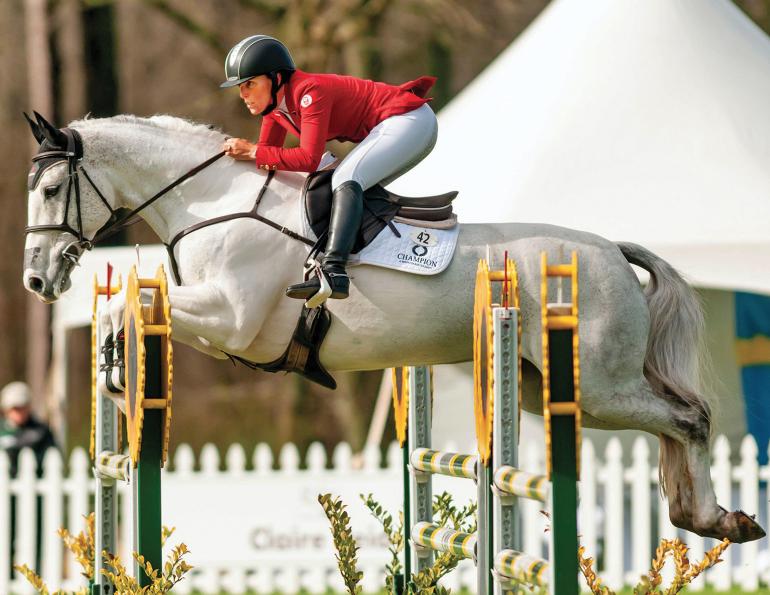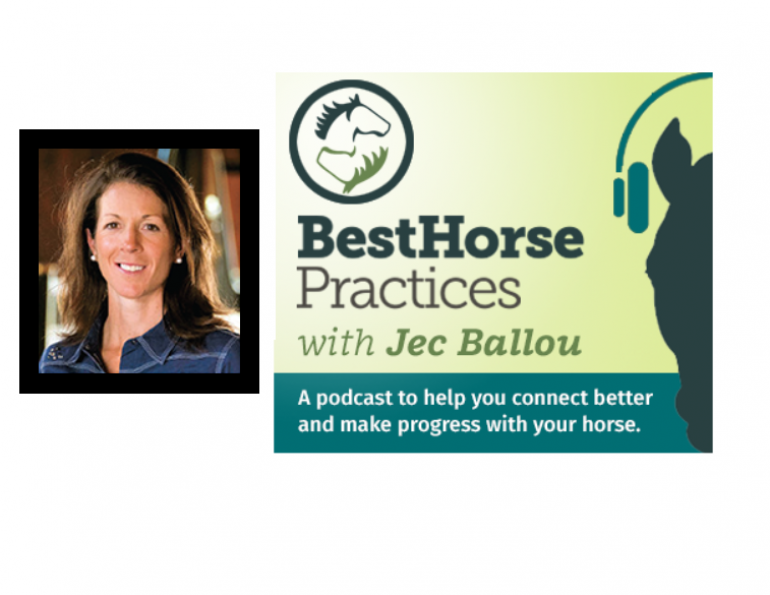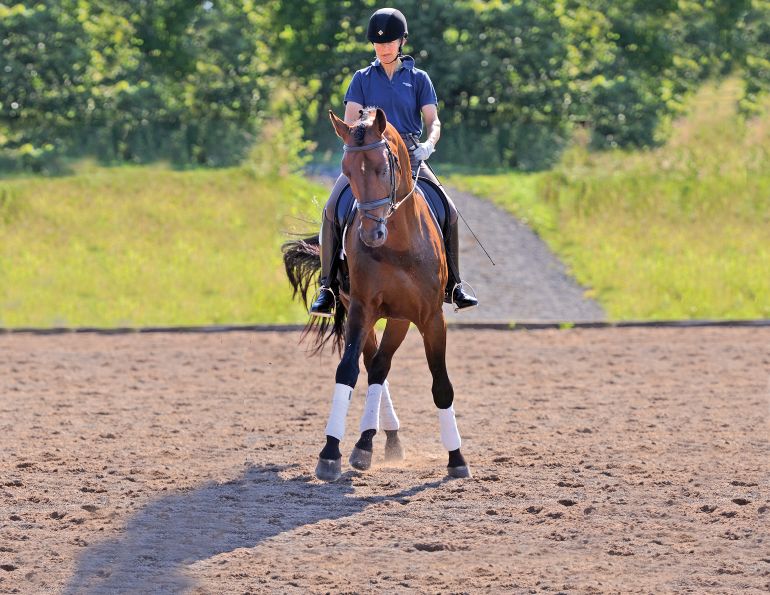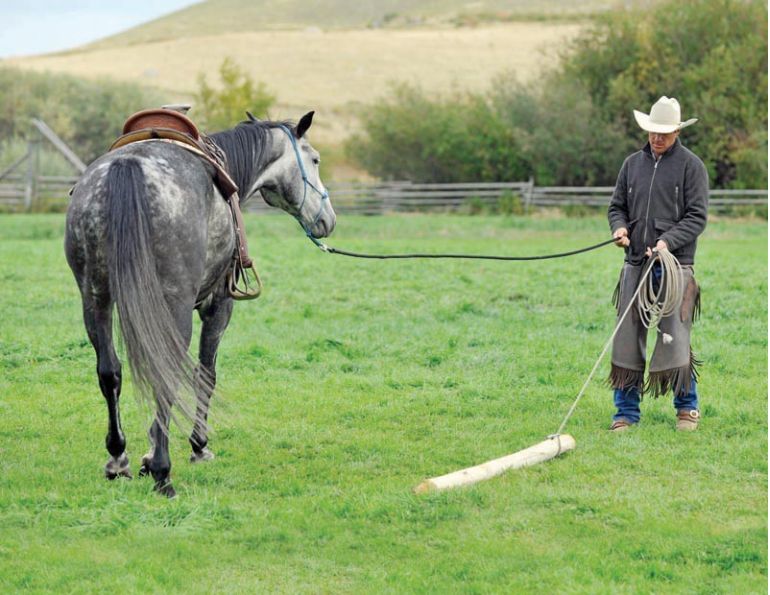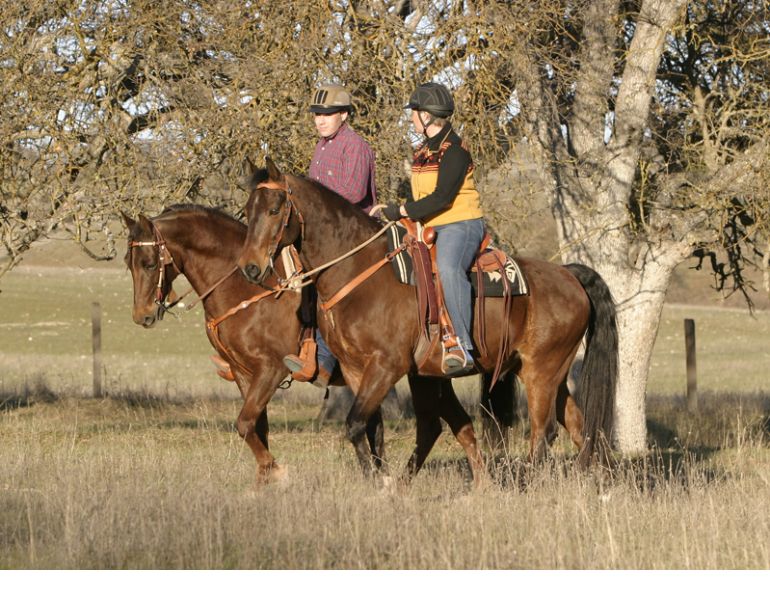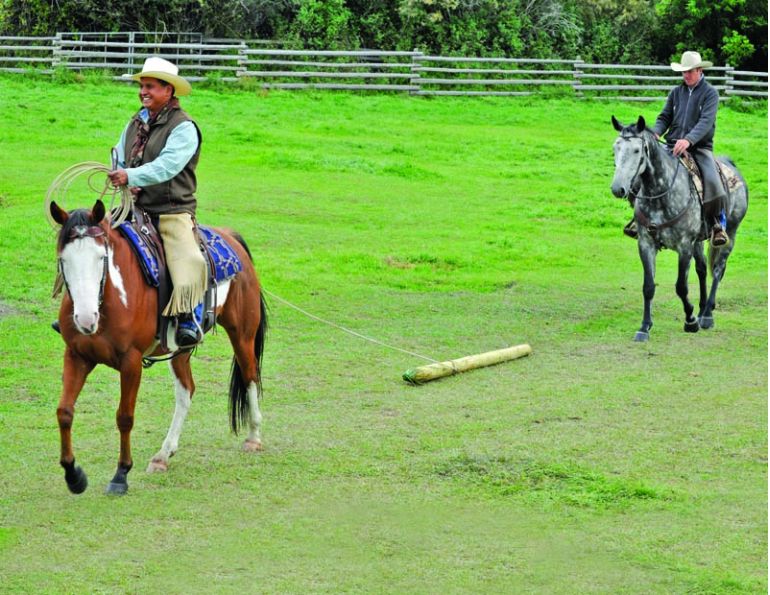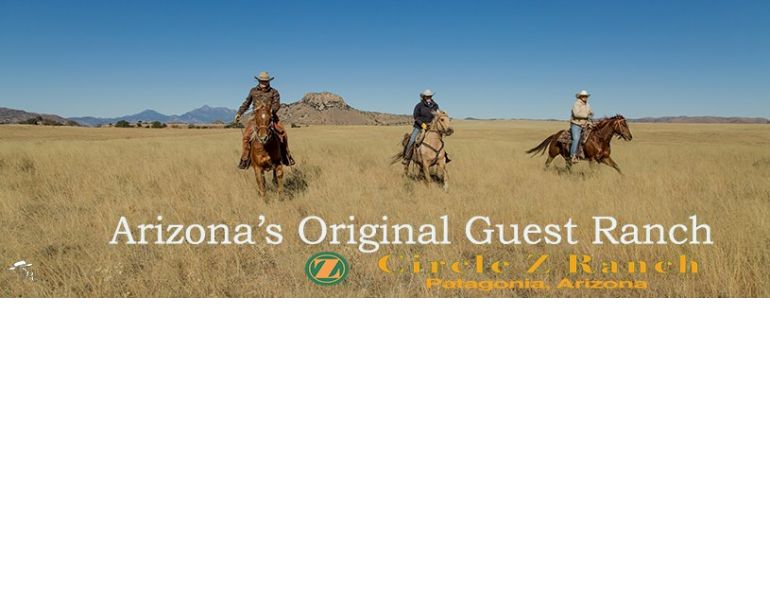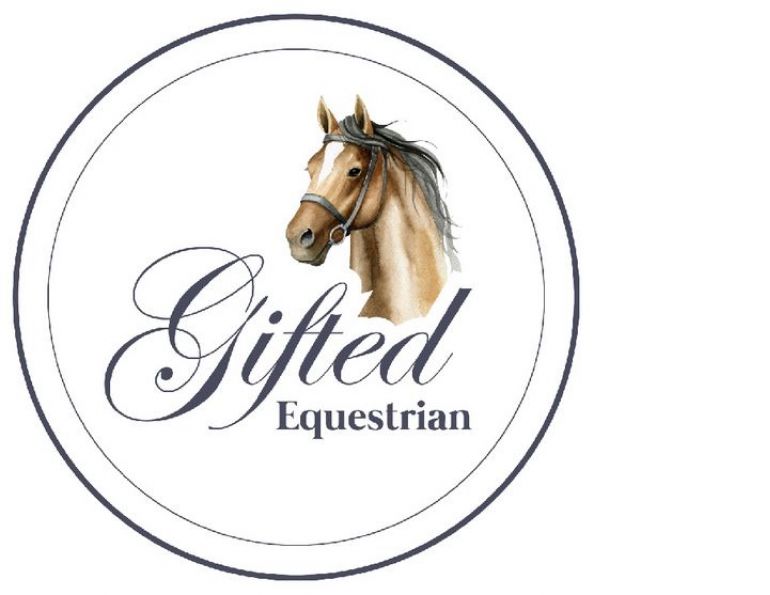By Stan Walchuk, Jr.
At 16 years of age I quit normal school and entered the school of hard knocks. (Don’t get any ideas kids, I have two degrees now). That August found me on a small dirt road that wound its way through central Yukon. A semi-load of horses had made its way up from a horse sale in Saskatchewan and the cowboys I was with had spent the last few days breaking and shoeing them. (In those days “breaking” was an accurate term). We saddled up, packed up, and hit the trail for some high mountain passes and a base camp at a remote lake. If I’d known what was in store for me, I probably would have walked. The outfitter gave me a sturdy palomino mare with pretty, round eyes and the devil in her heart. I’ve had an aversion to blondes ever since.
An hour or so into the trip I slipped my rain slicker from behind the saddle seat and a breath of wind lifted it like a sheet of newspaper rattling alongside the horse’s head. Well, I did not know a horse could jump so high; it was like flying without wings. Suddenly there was just space between me and the rocky Yukon trail. Landing hurt.
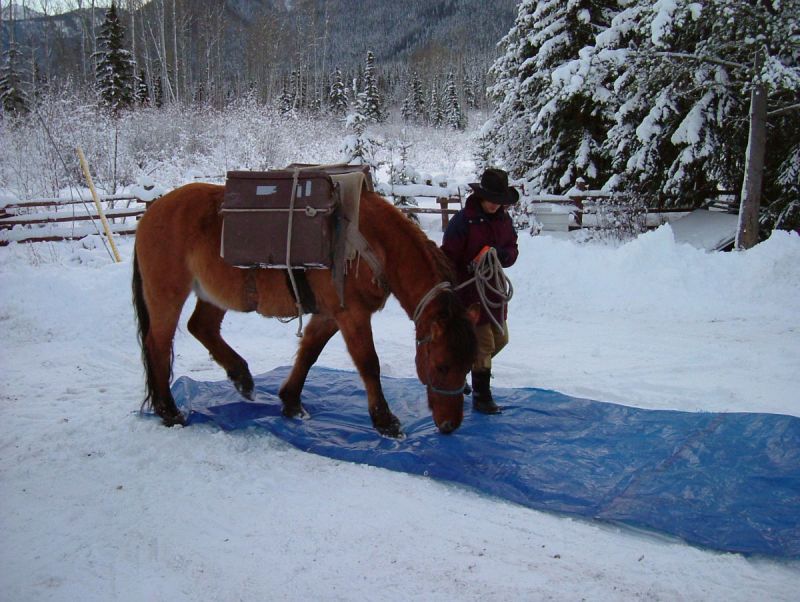
It is nice to know that your trail horse is desensitized enough to walk on a noisy poly tarp, but getting to that point takes time, patience, and starting with less frightening objects. Photo courtesy of Stan Walchuk, Jr
I don’t care what they say about keeping courage, showing the horse no fear, and getting back on again. I would have walked all that day and the next but for the fact that I had lost face with the cowboys (what little I had) and so I got on again and got bucked off a couple more times that day. That mare looked for reasons to spook and it was a major problem for me, but no problem at all for the horse!
Problem solving your trail horse’s faults can be a challenging and frustrating experience. I am both an optimist and a skeptic when confronted with a horse and its problems, depending on the problem and, more importantly, depending on the nature of the horse. Horses are like people: they come with all sorts of mental and emotional baggage. If someone is a serious claustrophobic, I am not convinced that a therapy session would guarantee that they would not fall to pieces if they happen to get locked in a closet.
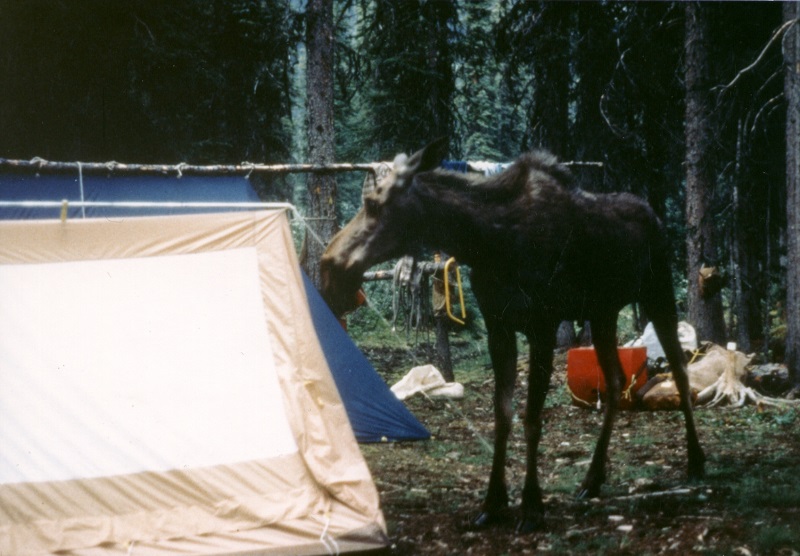
Want your horse to be as comfortable in the campsite as this moose, who calmly pulled down the author’s tent? Lots of work in the round pen or on a lunge line, and repeated and various desensitization are needed. Photo courtesy of Stan Walchuk, Jr.
I have successfully helped horses though all sorts of difficulties, from spooking to crossing water, bucking, and pulling. I am not ashamed to admit that I have given up on some horses that had deep-seated problems. Some horses improve to a point, but will not entirely lose their problems, and for our purposes trail horses must be completely reliable. It is no fun riding while sitting on pins and needles wondering if your horse will spook, buck, or pull back the next time you tie him.
Despooking the Trail Horse
Horses find a surprising number of ways to spook. Some do not like white rocks, some do not like black stumps or roots, some are terrified of vehicles and bicycles, some freak out at a chocolate bar wrapper or a pop can, and others are just paranoid of everything. Some horses seem to have moods when they ignore an object one day, then become convinced that it will be the death of them the next.
First of all, we need to remind ourselves that we are working with the mind of a flight animal. Because of this, the horse must have truly submitted to our control. You absolutely must be the dominant being in your trail horse’s life, otherwise why would he respect your command when you ask him to cross a stream? Why would he follow your cues and ride past an object he is afraid of? If a rider does not have control of a horse in the round pen, on a lunge line, when riding, or when doing other ground work, why would that rider have control if the horse is in a stressful circumstance where his mind is telling him to react in order to preserve himself? Trust, confidence, and responding to demands result from the rider being the dominant being and providing a comfort zone with their presence.
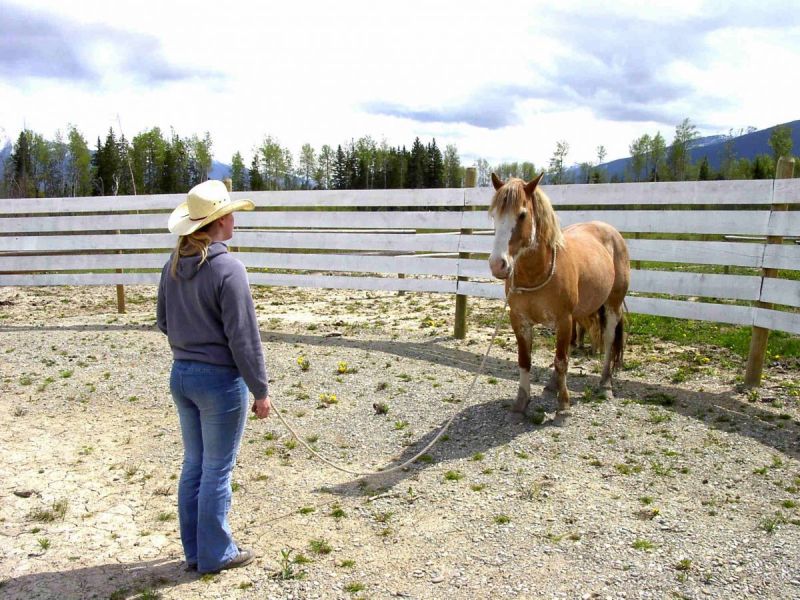
Complete join up and a relationship of trust and respect are fundamental to solving horse behaviour problems. Photo courtesy of Stan Walchuk, Jr.
So, before trying to cure any problem make sure that your horse is comfortable with your presence, that you have complete “join up” in the round pen or on a lunge line, and that the horse is responding softly when you apply cues, even if these are simple cues such as asking him to give his face softly, move over, back up, etc. Then you will really have the horse’s mind on your side and half your problem should be solved. Tying objects to the horse and chasing him around or letting him buck it out before creating a soft mind is asking for trouble and may create problems that will never get fixed.
Once you have completed round pen work and the horse is calm, soft, and under your control, it is a good idea to completely desensitize the horse at home before hitting the trails. In a sense, you are working the “spook” out of your horse before you ride. Ideally, this should have been done when the horse was a two-year-old or sooner.
First, be sure that your horse accepts your touch and gentle rubbing over his entire body. Begin at the shoulder area and rub the shoulder, neck, and back before proceeding to the girth, groin, tail, and ear areas. Be gentle and use common sense. Do not get yourself in the way of danger. I like the horse to accept the blunt end of a whip as a friend by gently rubbing it on his shoulders and back. Then, when you progress to the groin and rear areas, you can work at desensitizing without getting kicked.

Trail horses have all sorts of frightening objects to deal with, such as noisy pack tarps, strange stumps, busting grouse, and more. Spooking is not an option in your reliable trail mount. Photo courtesy of Stan Walchuk, Jr.
Once the horse accepts a few rubs, quit as a reward for accepting the procedure, and continue in another area. Be gentle around the ears and under the tail. Once the horse is calm with your hands or the blunt end of a whip or a soft jacket, you can progress to something noisy like a piece of plastic. (See Blue Creek’s Trail Riding, Packing, and Training manual for a complete description of desensitizing).
Hanging noisy objects from the saddle, such as a plastic jug with stones in it, or dragging a piece of plastic behind the horse in an attempt to get the horse used to spooky objects should never be attempted unless the horse is already desensitized and familiar with those objects. This needs to be done in stages in a controlled environment.
Dragging an object can be a fearful experience but the truth is that, sooner or later, a trail horse will have something dragging from him on the trail, maybe a coat, a pack tarp, a rope, or something else. I want the horse used to the experience at home, so that while there may be some surprise there should be no mad dash on the trail. If you drag an object behind a horse for the purpose of desensitizing, then do it in stages and in the controlled environment of a sturdy round pen. Start with soft, friendly objects like an old coat. Be sure that the rope you use to drag the object is at least ten feet long behind the horse, so that he is not kicking at the object as he walks out. The object should be soft and as non-threatening as possible.

If a rider lacks confidence, regular trail riding on a reliable, experienced mount will work wonders to improve self-assurance.
When your horse spooks or shies at an object on the trail, you are better off continuing to ride past or slightly around the object, rather than trying to force the horse’s nose into it. In other words, focus beyond the fearful object rather than on it — the horse will sense this.
When the horse rides past a scary object he feels a sense of relief and his confidence rises because it did not attack him. Next, ride a loop and go back past the object, slightly closer. Continue until you can ride close by with little or no reaction from the horse. In time, the horse will realize that he is made to do more work if he shies and will learn that an object is never as bad as he thought.
If you ride directly at the object and force the horse into it, you are setting yourself up for a battle. If the horse wins the battle it confirms for him that fighting was worth it because he was able to find a release by leaving the object. These types of battles also help to create a stiff-mouthed trail horse. If you feel that you need to bring him to the object, dismount, lead him to it, and spend some time there until he gets comfortable.
Many riders like a dominant horse up front on a trail ride. If the dominant horse has confidence and is a good lead horse then a horse following behind, who normally would have shied at an object, will often ride along with no fear. However, dominant horses with unreasonable fears can give their riders big battles when they spook because they are used to being in control.
The rider’s body language is important when riding a spooky horse. A fearful rider is tense and the horse can sense this tension and fear. A horse looks for the rider to be relaxed and to provide control, direction, and security; he depends on you for confidence.

Trail riding should be a relaxing, soul-refreshing experience that generates good times and great memories. Photo courtesy of Stan Walchuk, Jr.
If you do not have confidence, the horse will become confused, lose confidence, lose trust, and may take control and react to fearful situations in an exaggerated manner.
Trail riders need to remember that the reason they trail ride is to enjoy the trails and not to problem solve with difficult horses, and work toward that goal. If the rider lacks confidence, then finding a confident trail horse is the ticket. Simply getting out regularly and riding on a reliable mount will do wonders.
Taking your horse on a week-long or longer pack trip can do great things for your trail horse. A riding horse will often lose many fears including the fear of crossing water and of strange objects, providing he is not simply high maintenance and foolish.
Happy Trails!
Read more by Stan Walchuk on this site.
All photos courtesy of Stan Walchuk, Jr.
Main Photo: Some horses look for reasons to spook and see trail ghosts behind every bush. Want to have a good time on the trail? Get rid of the spook in your horse before hitting the trails.



